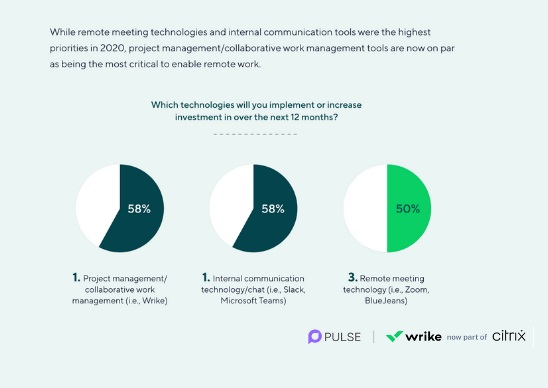Supply Chain (SCM/SCE)
Supply Chain Management (SCM) Software, Supply Chain Optimisation, Supply Chain Execution, hardware transport, supply-chain, distribution software, freight software and load planning in manufacturing and supply chain applications.Research Uncovers Pain Points IT Leaders Must Address To Power Hybrid Work

According to new research conducted by Wrike, the most intelligent and versatile collaborative work management platform, now part of Citrix, employee engagement (56%), burnout (53%), and reduced productivity (52%) are top concerns for IT leaders in 2021 and beyond, as they continue to enable remote workers and plan for new, hybrid workplace environments.
Last year’s shift to remote work compounded an already complex and distributed work environment, one cluttered with an array of heterogeneous applications and communication channels. The negative impact of this digital workplace chaos on employee efficiency and productivity is set to increase further, as the world enters the new era of hybrid work. As a result, nearly 60% of IT executives surveyed are prioritizing investments in solutions and strategies that power collaboration across the enterprise. In particular, they’ll focus on providing greater visibility into ownership across the organization (45%), enabling more secure collaboration (51%), and powering seamless external collaboration (46%).
“The pandemic put CIOs in the hot seat last year, forcing IT departments to accelerate digital strategies that would quickly support remote work and keep organizations running,” says Andrew Filev, Senior Vice President and Wrike General Manager, Citrix. “This first ‘COVID-19 wave’ of tech investment had 55% of respondents focused on basic, secure communications between remote teams. While those tools are important, they don’t alleviate the complexities of collaborating in a work-from-home model, which leads to burnout and major inefficiencies. That’s why we’re now seeing 58% of IT leaders — up from 17% one year ago — prioritizing powerful collaborative work management solutions in 2021 to help dispersed teams share and drive work in a systematic and cohesive manner.”
Going deeper into the report findings, data collected from Pulse’s executive knowledge community shows that IT leaders believe there are three key planning, process, and execution use cases that would benefit most from cohesive/enterprise-wide collaborative work management solutions: OKRs and company objectives, requests and approvals, and agile planning and execution. Fifty-eight percent of IT leaders confirmed that project management solutions tied with internal communications capabilities will be the number one tool they invest in this year to enable high-performing teams to execute with speed, precision, and agility.
Filev concludes, “What we’re seeing across enterprises is a strong CIO and leadership focus on establishing strategies that will enable the entire organization to work as one in a single digital workspace. By simplifying the way work gets done through sophisticated collaborative work management solutions, employees will have better visibility and alignment, make use of agile planning and execution, and realize OKRs and company objectives. It’s through this reimagination of ‘the future of work’ that companies will be able to achieve a happier workforce, no matter their location. And it’s well documented that happy employees demonstrate lower burnout and increased productivity levels.”
For more information on Wrike’s IT leader research, view the infographic.
Research Methodology:
Leveraging the Pulse executive knowledge community, Wrike surveyed more than 300 IT leaders, including CIOs, IT VPs, directors, and managers from organizations with more than 1,000 employees in North America, EMEA, and APAC.










